Scarsdale Ladies Tennis Team Takes Home the Trophy
- Details
- Written by Joanne Wallenstein
- Hits: 4713
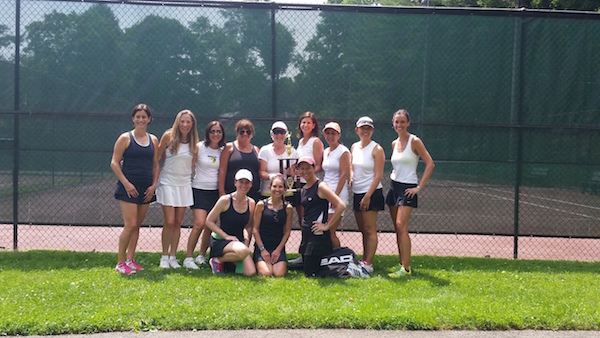 The Scarsdale B2 women's tennis team represented the village in the league finals on Tuesday June 23 against Briarcliff Manor, after defeating Chappaqua in the semi-finals. Following the final match, team member Tammy Fine said, "We had a fabulous team and came up a little short today but there is a nice trophy to add to the Scarsdale collection!"
The Scarsdale B2 women's tennis team represented the village in the league finals on Tuesday June 23 against Briarcliff Manor, after defeating Chappaqua in the semi-finals. Following the final match, team member Tammy Fine said, "We had a fabulous team and came up a little short today but there is a nice trophy to add to the Scarsdale collection!"
Congratulations to team captains Wendie Kroll, Helyn Goldstein, Shari Romano and Michelle Silberberg and team members Tammy Fine, Geralyn Della Cava, Amy Cooper, Nancy Clarvit, Diane Loft, Joanne Teoh, Sarah Roth, Alexa Froomberg, Debra Distler, Florence Alkalay, Barbara Goodman, Erika Radin, Jill Hyman, Karen Cohn, Lauren Haller, Mayu Kojima, Karen Friedman, Tracy McCarthy, Yuko Onado, Lydia Hassan and Melissa Bornstein.
A House with a History
- Details
- Hits: 6399
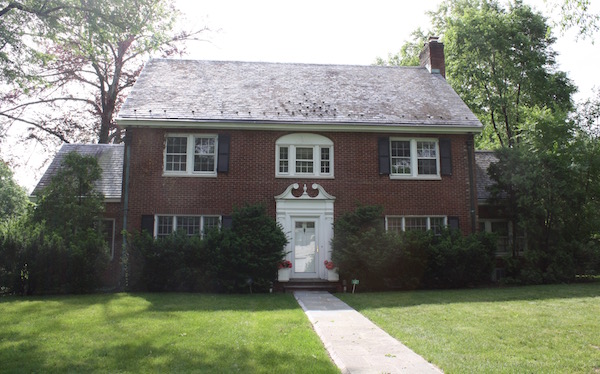 A long time ago, in a place not so far, far away...lived a man and his family, on 66 Brite Avenue in Scarsdale New York. This was the Friedlander family, who moved into the Village of Scarsdale, bought an empty plot of land, and built their own house in 1932. Modestly renovated over the years, it still stands today. Dr. Bernard Friedlander was the youngest of the family, attending Fox Meadow Elementary in the late 1930's. Today 66 Brite is home to my family of four, my mom, dad, my 18 year-old twin sister and me.
A long time ago, in a place not so far, far away...lived a man and his family, on 66 Brite Avenue in Scarsdale New York. This was the Friedlander family, who moved into the Village of Scarsdale, bought an empty plot of land, and built their own house in 1932. Modestly renovated over the years, it still stands today. Dr. Bernard Friedlander was the youngest of the family, attending Fox Meadow Elementary in the late 1930's. Today 66 Brite is home to my family of four, my mom, dad, my 18 year-old twin sister and me.
In May, Dr. Friedlander returned to Scarsdale to visit the house for the first time since his family sold it in August of 1944. As the current resident of the house, I spoke to him and heard all of his nostalgic stories. Though he did not offer his age, we guessed he was in his 80's. He explained all the "modern conveniences" in the house at that time, which seemed anything but modern to a tech-savvy teen in 2015. We always wondered why there appeared to be a trap door in the basement and he told us that it was a "log box" with a passage into the living room, to allow the handyman to deliver firewood without having to walk around the outside of the house and through the front door. He explained that the box beneath the telephone ledge, a modern luxury in the 1930s, housed the bell system, which was used to summon the live-in maid. The bells can be better seen in my room, which was the former maid's room, on the third floor of the house.
Two homes that are now across the street were not there in Friedlander's time. The lot where they now stand was a deep lot that stretched all the way from Oak Lane to Brite Avenue and became Bernard and his older brother Henry's play area. The owner at the time, a Mr. Steinberger, was tolerant of the boys, until one day, when they pushed their luck too far. Bernard, his brother, their friends and cousins set up an archery range in the yard, firing towards Mr. Steinberger's house, which they thought was a good distance away. During one such archery session, Dr. Friedlander remembers Mr. Steinberger running up the yard, shaking his hat in one hand and one of their arrows in the other. "This arrow just went through the brim of my hat!" bellowed Mr. Steinberger, frightening the children off his yard. Soon after, the archery range was moved.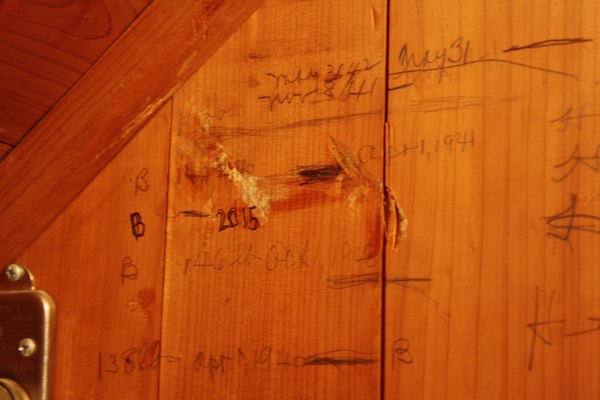
Today families often gather in living rooms at night to catch up on their favorite TV shows or news programs and spend quality time together. Dr. Friedlander recalls sitting with his family and listening to their favorite radio shows. He remembers helping his father spray pesticides on the trees in the yard, pumping the pesticide through his father's hose while straining his ear to hear the latest jokes on the Jack Benny Show, which was broadcast into the driveway from a radio in the kitchen window. He also remembered the night that the disturbing news of the Japanese attack on Pearl Harbor interrupted the radio broadcast. Dr. Friedlander said his family was fortunate to own the radio at the time and how similar the radio culture was to TV culture today.
The home at 66 Brite Ave has a few attractions that now seem commonplace. For example, an old bay window on the north side of the house was an architecture marvel during Friedlander's years, as it was one of the first freestanding bay windows. Dr. Friedlander remembers that people used to come to the house and photograph or sketch the window in order to study the architecture. Furthermore, the Friedlander's installed a dumbwaiter system that broke back then and was used instead as a laundry chute. We still throw our clothes down the chute today.
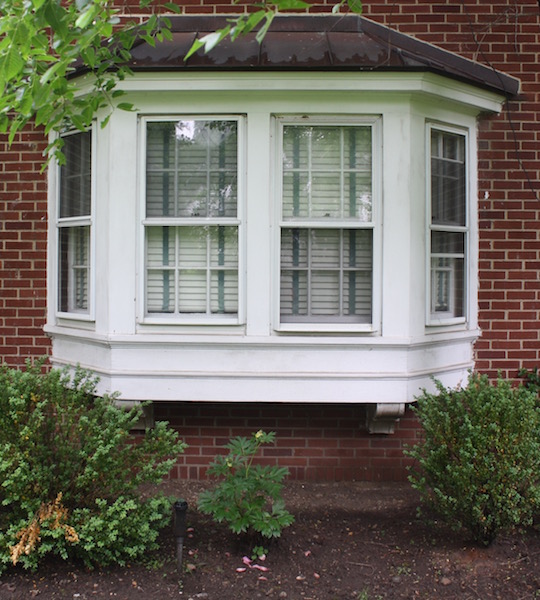 One of the best portions of Dr. Friedlander's visit was our trip to the second floor closet by his old room, where he cleared up a mystery that has perplexed my family for years. In that closet there are a series of pencil marks with corresponding dates and letters, such as B Oct 1939, H Oct 1940. It was not until Dr. Bernard Friedlander explained these letters did we fully understand the significance. The marks were height measurements for himself and his older brother Henry as they grew. These marks remain in the closet wall between Bernard and Henry's rooms. During his visit, we measured Dr. Friedlander and we were able to update his height chart as of May 2015. We found that he had actually shrunk.
One of the best portions of Dr. Friedlander's visit was our trip to the second floor closet by his old room, where he cleared up a mystery that has perplexed my family for years. In that closet there are a series of pencil marks with corresponding dates and letters, such as B Oct 1939, H Oct 1940. It was not until Dr. Bernard Friedlander explained these letters did we fully understand the significance. The marks were height measurements for himself and his older brother Henry as they grew. These marks remain in the closet wall between Bernard and Henry's rooms. During his visit, we measured Dr. Friedlander and we were able to update his height chart as of May 2015. We found that he had actually shrunk.
Dr. Friedlander asked if he could plant a peony in remembrance of his parents on the property. My father obliged and planted it beneath the unique bay window, Dr. Friedlander's mother's favorite window in the house.
Greenacres Elementary PTA President Taking it to New Heights
- Details
- Written by Midori Im
- Hits: 3309
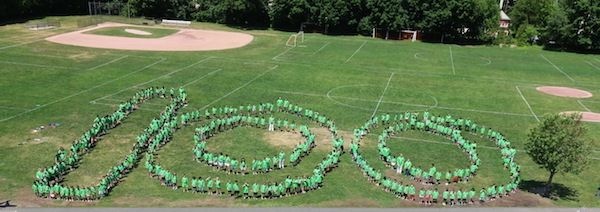 PTA President Isabel Finegold didn't realize that she could get so carried away in her position of leadership. Though not a great fan of heights, she agreed to be transported on May 29th for an aerial shot of the Greenacres students and staff as they lined up to form a "100" in commemoration of the hundredth anniversary of the Greenacres school, the oldest public school in the district. With the support (literally) of the Scarsdale Fire Department, Mrs. Finegold was transported about 70 feet in the air to take the photograph. Though she has spent several years at the school, both as a student and then as a parent, this bird's-eye view certainly gave her a new perspective on the school. This is one of several special events Greenacres will hold in 2015 to commemorate the school's centennial, culminating in a huge celebration with current parents, alumni, and members of the Greenacres community on the evening of November 20, 2015.
PTA President Isabel Finegold didn't realize that she could get so carried away in her position of leadership. Though not a great fan of heights, she agreed to be transported on May 29th for an aerial shot of the Greenacres students and staff as they lined up to form a "100" in commemoration of the hundredth anniversary of the Greenacres school, the oldest public school in the district. With the support (literally) of the Scarsdale Fire Department, Mrs. Finegold was transported about 70 feet in the air to take the photograph. Though she has spent several years at the school, both as a student and then as a parent, this bird's-eye view certainly gave her a new perspective on the school. This is one of several special events Greenacres will hold in 2015 to commemorate the school's centennial, culminating in a huge celebration with current parents, alumni, and members of the Greenacres community on the evening of November 20, 2015.
Photos courtesy of Isabel Finegold and Sharon Higgins.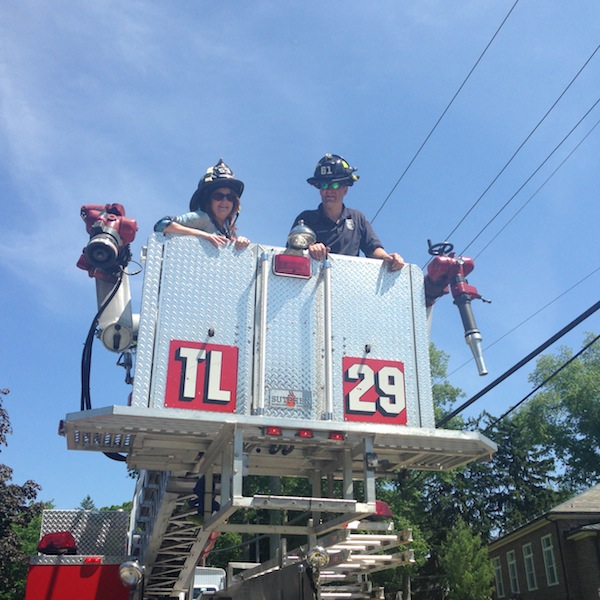
BOE Reassures Greenacres Residents and Recognizes Four Retiring Staffers
- Details
- Written by Joanne Wallenstein
- Hits: 4345
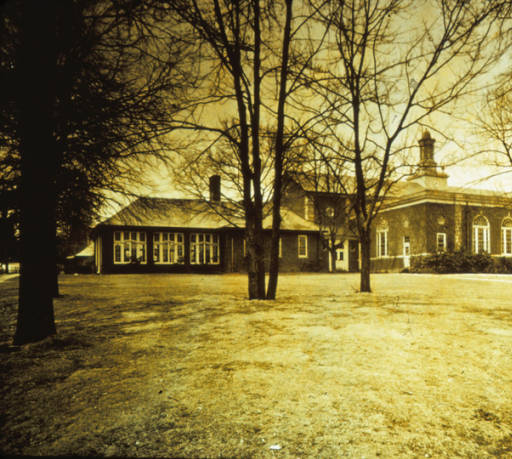 The Board of Education sought to assure Greenacres residents that a decision about the status of the school was far from a done deal at their meeting on Monday June 8th. Responding to Greenacres petitioners who objected to consideration of an option on a feasibility study to construct a new school on Greenacres Field, Board Vice President Lee Shames Maude said, "The Board wants the community to know that no decision will be made without "considerable input from the community."
The Board of Education sought to assure Greenacres residents that a decision about the status of the school was far from a done deal at their meeting on Monday June 8th. Responding to Greenacres petitioners who objected to consideration of an option on a feasibility study to construct a new school on Greenacres Field, Board Vice President Lee Shames Maude said, "The Board wants the community to know that no decision will be made without "considerable input from the community."
Maude read a statement from the Board that described their actions to date and laid out a plan to gather information, weigh options and listen to community input in the future.
She said that the current steering committee had conducted an extensive tour of the school on June 3 and 4, seeing every floor including the basement where they examined the boilers and electric service. They held a meeting on June 3rd and reviewed the feasibility study from architects KG&D and considered the options and the need for field space, parking space and the community's desire to maintain open space. They have scheduled another meeting to examine their options and will then issue a report with recommendations and next steps.
Maude reviewed the four options and said that "nothing has been decided." She said the committee could ask the architects to explore more options or further study one or two of the existing options.
The four options in the current feasibility study are as follows:
Option 1: Repair the infrastructure but make no changes to the existing layout
Option 2: Do internal renovations to adapt classroom size and layout – with no additions to the school. This would require redistricting about 75 students.
Option 3: Do internal renovations and put an addition on the northwest corner of the school to accommodate enrollment and address adequacy issues.
Option 4: Build a new school across the street and turn the existing site into a field
Maude said that the new board will form a district steering committee by the fall of 2015 that will include broad representation from the district as well as Greenacres stakeholders. Down the road, steering committee meetings will be open to the public and will follow the same procedure that was used for the consideration of other major capitol projects. A bond vote on this issue will be held in December 2016 to coincide with the retirement of other district debt.
Several residents commented at the meeting:
John Singer of Brewster Road said that the petition to take Option 4 off the table had been signed by 780 people, representing 470 households. He said, "Our group is happy that you are taking the updating of the school seriously." However, he said, "We want to join you in a more open process ... and we "would like to be part of the steering committee." He continued, "When release your study please release all the mechanical studies and the population study." And concluded by saying, "We still ask you to take the option of building a new school off the table so that you can focus your time on an effort that will succeed."
Aaron Lamport of Huntington Avenue said he is an architect who focuses on the re-use of buildings for educational use. He said that "little information about the existing facility has been provided." He asked the board to consider re-orienting the building so that it faces Huntington Avenue thereby reducing the traffic on the side streets. He said the field is an "asset for the community and the school."
Vivienne Braun of Kingston Road said that the Recreation Department reported that Greenacres is one of the most heavily used fields in the community. She said "there is already a shortage of fields," and that using it for the school would "affect youth sports." She asked the Board to consider this loss.
Mike Greenberg, the former president of Scarsdale Little League said "we are perennially short of fields every year." He called Greenacres "a historically significant and beautiful building" that "cannot be easily replicated." He continued, saying "In NYC it would easily be landmarked."
Joel Gantcher, said, "I keep hearing things about water infiltration and mold.
Shouldn't' we be addressing the mold immediately?"
Harry Green, a new resident at Brewster Road said he was the father of three young boys who chose Greenacres because of the school and community. He said, "the field is the epicenter."
Retirements:
The Scarsdale Board of Education recognized three retiring faculty members from Greenacres and a staffer from the central office at their meeting on Monday night. Second grade teacher Jo Ann Nahabedian, Teacher-in-Charge Cindy Sansone and Occupational Therapist Aqualina Viani will retire from Greenacres. Vivi Samoladdas, who worked with Dr. Joan Weber in the central office, will also retire in June.
Cindy Sansone, the Teacher-in-Charge at Greenacres, will retire after 30 years at the school. She began her career in Scarsdale as a teacher's aide. She worked her way up, taking over a kindergarten class midway through the school year, and has since become a valued member of the Greenacres staff. She is an avid reader and a literacy and math expert. She also played a role in organizing some of the non-academic activities at the school - organizing the holiday toy drive, the food drive, the pajama drive and midnight run. Principal Sharon Hill said, these events "just won't be the same without her." Parents were impressed with Sansone's dedication and commitment to the community service practices at Greenacres. Speaking for the parents, PTA President Isable Finegold said, "Mrs. Sansone has done amazing work with the Community Service Committee – we have been so, so lucky to have her... She has educated our student population about the importance of community service and given to those in need." Mrs. Sansone has "transformed Greenacres ever since she was a teacher's aide ... and positively affected everything and everyone at Greenacres. "
About Sansone, Finegold said, "Mrs. Sansone, for the parents who have been privileged to know and work with you, you are valued as a teacher, administrator and friend. You leave behind a beautiful legacy in all that you have given students, teachers, staff, and principals at Greenacres. The PTA wishes you the very, very best in your retirement."
PTA President Isabel Finegold said that parents commented that Jo Ann Nahabedian really understood her students. They said that after a few short weeks with their child, Mrs. Nahabedian was already extremely knowledgeable about a students needs. She was a dedicated student of the arts, and reflected this in her classroom, teaching extensively about Monet and Picasso. She cultivated a love for the arts and culture in her students. She said Nahabedian "was a fantastic teacher, who will be missed."
Vivi Samoladdas is a member of Dr. Weber's staff in the District offices. Dr. Weber, who will also retire this year, called her "an invaluable asset," and added that she was talented in the kitchen. Weber said, "others quickly learned of Mrs. Samoladdas' excellence as a chef, during a time when people were not as interested in cooking. " Weber said, "The theme is that retirement allows for more time to spend with the grandkids."
Aqualina Viani, the Occupational Therapist at Greenacres and Fox Meadow was the final teacher to be honored at the meeting. Mrs. Viani was known for her uncanny ability to perform her work with children and have them eager to return, as she made work fun, and made it seem and feel like play. She was also known to put her students above everything else, creating custom tools to aide her students. Parents commented that their children loved working with Ms. Viani, and that those meetings "quickly became the highlight of the week." She worked with a calm head, and a cool manner, reassuring parents about their children, believing that "children will overcome any challenges."
The Heathcote School: Progressive Design for Now and Then
- Details
- Written by Joanne Wallenstein
- Hits: 16695
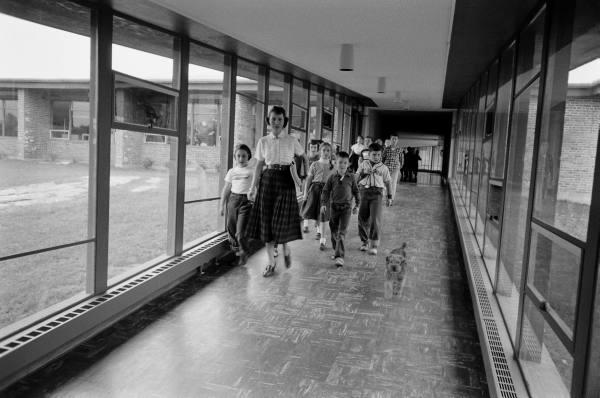 In the days before mid-century architecture became retro, it was considered modern. And when it was built in 1954, the Heathcote School in Scarsdale set the standard for modern school design. Last week, a busload of architects from the firm Perkins + Will, who designed the original school, came to tour this landmark.
In the days before mid-century architecture became retro, it was considered modern. And when it was built in 1954, the Heathcote School in Scarsdale set the standard for modern school design. Last week, a busload of architects from the firm Perkins + Will, who designed the original school, came to tour this landmark.
Designed by Lawrence B. Perkins, the progressive layout included four pods or clusters, rather than perpendicular hallways lined with classrooms. Each pod included classrooms and a central meeting space that could be used for flexible learning. The exterior walls of the school were made with glass rather than brick to bring the outside inside.
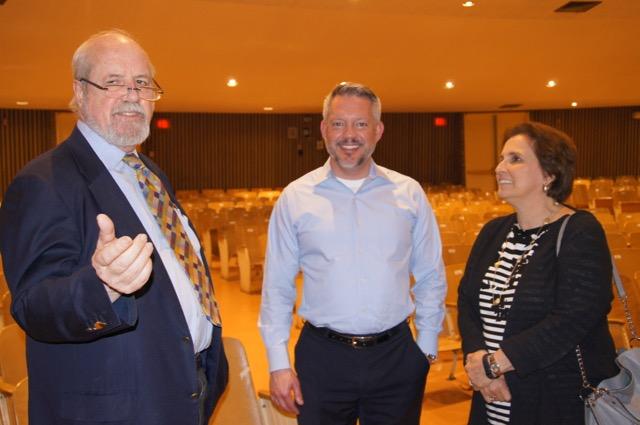 Brad Perkins, a Scarsdale resident who is the son of the architect and an architect himself, greeted the visitors and explained that the Heathcote School was the second innovative school that his father designed. The first was Crow Island, in Winnetka Illinois, another landmark school that coincidentally is the previous home of Scarsdale's new superintendent, Thomas Hagerman.
Brad Perkins, a Scarsdale resident who is the son of the architect and an architect himself, greeted the visitors and explained that the Heathcote School was the second innovative school that his father designed. The first was Crow Island, in Winnetka Illinois, another landmark school that coincidentally is the previous home of Scarsdale's new superintendent, Thomas Hagerman.
Built in 1941, Crow Island shares many features with Heathcote. 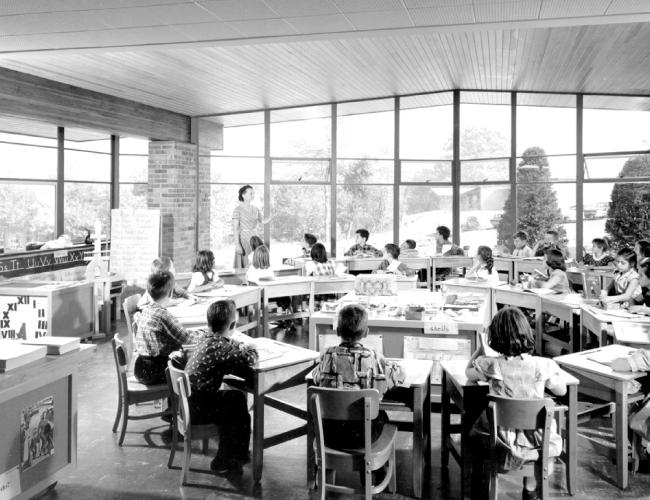 It too was designed by Lawrence B. Perkins – who worked with famed architect Eero Saarinen. Classrooms were grouped in three separate wings according to age and connected by a core of rooms for common use: the auditorium, library, gym, activities room, administration, and so forth. The grounds and play area extending from the classroom wings were also zoned according to age groups to allow for increased freedom and greater safety in play activities. The school won the American Institute of Architects' 25-Year Award, an award that had been given only once before, to the Rockefeller Center in New York City.
It too was designed by Lawrence B. Perkins – who worked with famed architect Eero Saarinen. Classrooms were grouped in three separate wings according to age and connected by a core of rooms for common use: the auditorium, library, gym, activities room, administration, and so forth. The grounds and play area extending from the classroom wings were also zoned according to age groups to allow for increased freedom and greater safety in play activities. The school won the American Institute of Architects' 25-Year Award, an award that had been given only once before, to the Rockefeller Center in New York City.
We had the pleasure of touring the Heathcote School with the architects, and here is what we learned from Joan Blumenfeld of Perkins + Will. The design of the Heathcote School was a departure from traditional school plans. Some of the design elements that were unique and forward-thinking at the time include:
- Classrooms in pods, or clusters, to create smaller subgroups within the school, thus encouraging a greater sense of community for young children.
- Central space in between classrooms that can be used for alternative learning spaces, or for group activities.
- Flexible layouts in the classrooms, allowing the teachers to arrange the furniture differently for different learning activities
- There are no traditional desks facing in a row facing the teacher, for teachers to teach down to the students. The plans encourage interactive learning, allowing for many different kinds of learning activities during the day.
- The idea that learning occurs outside the classroom as well as inside, encouraging physical activity and the engagement with the outdoors. The large windows on all sides of the classrooms, the glass corridors, all make the outside inside relationship stronger.
- Single loading all the corridors, or having them have glass on both sides, allows natural light into them along with views to the outside. There has been lots of research linking better learning outcomes when students have access to daylight and views.
- Using the idea of creating a comfortable environment, such as having a fireplace and little "living room" in the library, so that children can learn in an informal atmosphere.
- Centralizing the shared spaces, such as the auditorium and administration areas, so that they are equidistant from the classrooms. This also allows the classrooms to be at "dead ends" so that there is less traffic in the corridors.
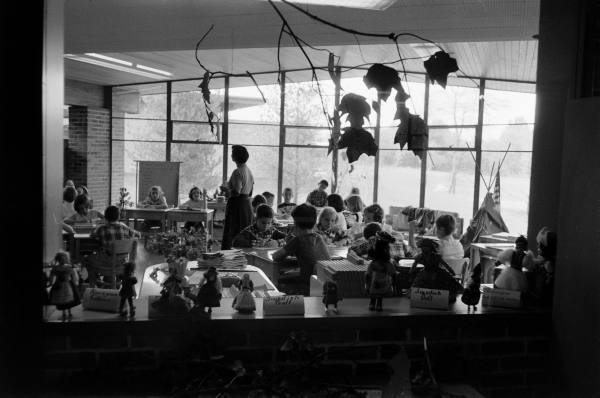 All of these features are emulated in school design today.
All of these features are emulated in school design today.
Some of the features of the school did not stand the test of time. The classrooms were designed for small groups, and there was less "stuff" in them when they were designed, so that they are now a bit cramped, and have inadequate storage space. The lighting and ventilation has been upgraded and the windows have been replaced with more energy efficient models. Technology has been added on, as there was little or none when the school was designed, but as a result it is not well integrated.
We wondered why the school has no cafeteria and were told that at the time Heathcote was built, there was no need for a cafeteria as mothers did not work and children went home for lunch.
Some Scarsdale residents might ask about the relationship between Perkins +Will, the firm that designed the Heathcote School and Perkins Eastman, the firm that designed the new commercial building at the Heathcote Five Corners. Perkins+Will was headed by Larry Perkins and Phil Will when they designed Heathcote School, built in 1953. By the 1980's they had retired and were succeeded by a number of other partners, among them Larry Perkins' son, Brad Perkins. Brad Perkins, along with Mary Jane Eastman, split off from Perkins+Will to form their own firm, eventually named Perkins Eastman, in 1981. The building on Palmer Avenue is by Brad Perkins, along with a local partner.












